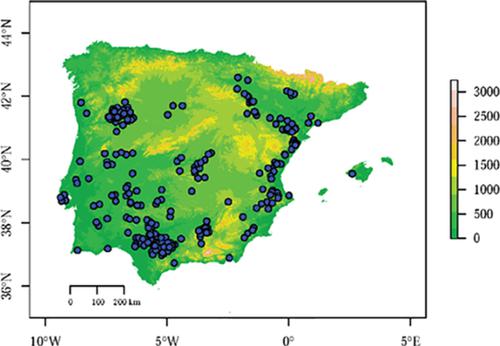当前位置:
X-MOL 学术
›
Ann. Appl. Biol.
›
论文详情
Our official English website, www.x-mol.net, welcomes your feedback! (Note: you will need to create a separate account there.)
Distribution of Bactrocera oleae (Rossi, 1790) throughout the Iberian Peninsula based on a maximum entropy modelling approach
Annals of Applied Biology ( IF 2.6 ) Pub Date : 2020-03-31 , DOI: 10.1111/aab.12584 Jacinto Benhadi‐Marín 1 , Sónia A.P. Santos 2, 3 , Paula Baptista 1 , José Alberto Pereira 1
Annals of Applied Biology ( IF 2.6 ) Pub Date : 2020-03-31 , DOI: 10.1111/aab.12584 Jacinto Benhadi‐Marín 1 , Sónia A.P. Santos 2, 3 , Paula Baptista 1 , José Alberto Pereira 1
Affiliation

|
The Iberian Peninsula (Portugal and Spain) is a great production area of olives. The fruit production can be severely affected by the olive fruit fly, Bactrocera oleae (Rossi, 1790) (Diptera). Detailed geographical distribution maps of key pests, such as B. oleae, are essential for their integrated management. Although different sources reporting the occurrence of B. oleae are available for sub‐regions of Portugal and Spain, the data available are dispersed and centralisation of this information considering the Iberian Peninsula as a faunistic geographical unit is currently lacking. In this work, we built two distribution maps of B. oleae throughout the Iberian Peninsula, one based on occurrence sites and another based on its bioclimatic habitat suitability. After modelling the bioclimatic suitability of B. oleae using a maximum entropy model, three potential distribution areas beyond the previously known occurrence range of the olive fruit fly were identified corresponding to the autonomous community of Galicia (Spain), the Spanish and Portuguese sides of the International Douro Natural Park, and the autonomous community of Castilla y León (Spain). Interestingly, each region houses nowadays autochthonous olive cultivars. The drivers that most contributed to the model were the precipitation of the coldest quarter and the precipitation of driest month which agrees with the B. oleae bioecology. Although our approach is not fully‐comprehensive in terms of occurrence sites, we show how a maxent modelling approach can be useful to identify potential risk areas of B. oleae occurrence throughout a target geographical extent such as the Iberian Peninsula.
中文翻译:

基于最大熵建模方法的油生小杆菌(Rossi,1790年)分布在整个伊比利亚半岛
伊比利亚半岛(葡萄牙和西班牙)是橄榄的重要产区。橄榄果蝇Bactrocera oleae(Rossi,1790)(Diptera)可能严重影响果实的产量。详细的地理分布图对于诸如B. oleae的主要有害生物是对其综合管理必不可少的。尽管可以从葡萄牙和西班牙的次区域获得报告油菜芽孢杆菌发生情况的不同来源,但是由于伊比利亚半岛是一个不完整的地理单位,因此可获得的数据分散并且集中了这些信息。在这项工作中,我们建立了油菜双歧杆菌的两个分布图在整个伊比利亚半岛,一个基于发生地点,另一个基于其生物气候栖息地的适宜性。在使用最大熵模型对油菜双歧杆菌的生物气候适应性进行建模后,确定了橄榄果蝇先前已知的发生范围以外的三个潜在分布区域,分别对应于加利西亚(西班牙),西班牙和葡萄牙的自治区。国际杜罗自然公园和卡斯蒂利亚-莱昂自治区(西班牙)。有趣的是,如今每个地区都种植有土生的橄榄品种。对模型贡献最大的驱动因素是最寒冷的四分之一的降水和最干燥月份的降水,这与油菜双歧杆菌一致。生物生态学。尽管我们的方法在发生地点方面不是很全面,但是我们展示了如何用最大的建模方法在整个目标地理范围(例如伊比利亚半岛)中识别油菜双歧杆菌发生的潜在风险区域。
更新日期:2020-03-31
中文翻译:

基于最大熵建模方法的油生小杆菌(Rossi,1790年)分布在整个伊比利亚半岛
伊比利亚半岛(葡萄牙和西班牙)是橄榄的重要产区。橄榄果蝇Bactrocera oleae(Rossi,1790)(Diptera)可能严重影响果实的产量。详细的地理分布图对于诸如B. oleae的主要有害生物是对其综合管理必不可少的。尽管可以从葡萄牙和西班牙的次区域获得报告油菜芽孢杆菌发生情况的不同来源,但是由于伊比利亚半岛是一个不完整的地理单位,因此可获得的数据分散并且集中了这些信息。在这项工作中,我们建立了油菜双歧杆菌的两个分布图在整个伊比利亚半岛,一个基于发生地点,另一个基于其生物气候栖息地的适宜性。在使用最大熵模型对油菜双歧杆菌的生物气候适应性进行建模后,确定了橄榄果蝇先前已知的发生范围以外的三个潜在分布区域,分别对应于加利西亚(西班牙),西班牙和葡萄牙的自治区。国际杜罗自然公园和卡斯蒂利亚-莱昂自治区(西班牙)。有趣的是,如今每个地区都种植有土生的橄榄品种。对模型贡献最大的驱动因素是最寒冷的四分之一的降水和最干燥月份的降水,这与油菜双歧杆菌一致。生物生态学。尽管我们的方法在发生地点方面不是很全面,但是我们展示了如何用最大的建模方法在整个目标地理范围(例如伊比利亚半岛)中识别油菜双歧杆菌发生的潜在风险区域。


























 京公网安备 11010802027423号
京公网安备 11010802027423号